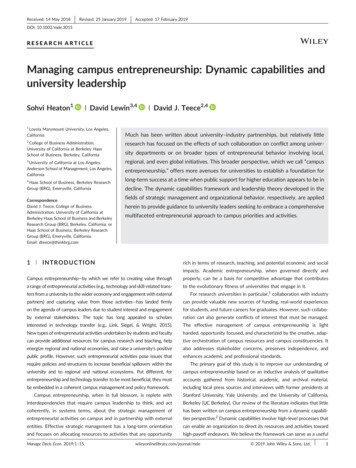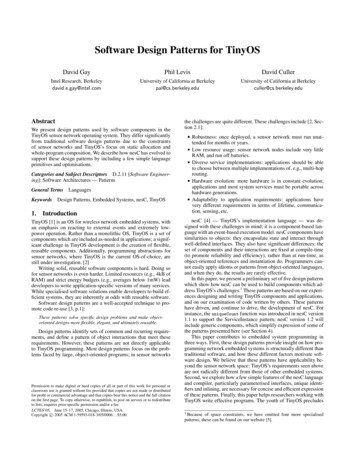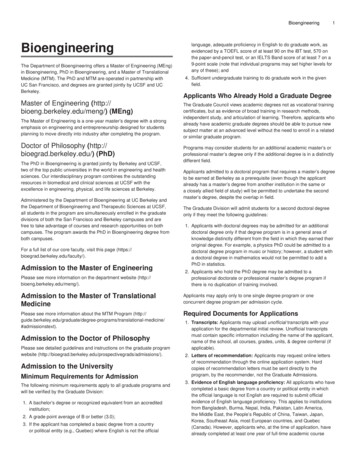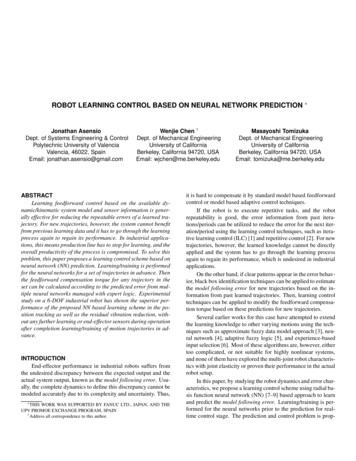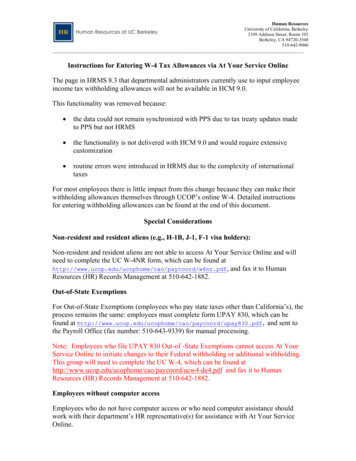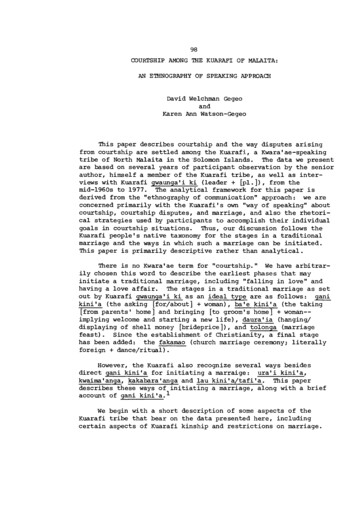
Transcription
98COURTSHIP AMONG THE KUARAFI OF MALAITA:AN ETHNOGRAPHY OF SPEAKING APPROACHDavid Welchman GegeoandKaren Ann Watson-GegeoThis paper describes courtship and the way disputes arisingfrom courtship are settled among the Kuarafi, a Kwara'ae-speakingtribe of North Malaita in the Solomon Islands. The data we presentare based on several years of participant observation by the seniorauthor, himself a member of the Kuarafi tribe, as well as interviews with Kuarafi gwaunga'i ki (leader [pl.]), from themid-1960s to 1977. The analytical framework for this paper isderived from the "ethnography of communication" approach: we areconcerned primarily with the Kuarafi's own "way of speaking" aboutcourtship, courtship disputes, and marriage, and also the rhetorical strategies used by participants to accomplish their individualgoals in courtship situations. Thus, our discussion follows theKuarafi people's native taxonomy for the stages in a traditionalmarriage and the ways in which such a marriage can be initiated.This paper is primarily descriptive rather than analytical.There is no Kwara'ae term for "courtship." We have arbitrarily chosen this word to describe the earliest phases that mayinitiate a traditional marriage, including "falling in love" andhaving a love affair. The stages in a traditional marriage as setout by Kuarafi gwaunga'i ki as an ideal type are as follows: ganikini'a (the asking [for/about] woman), ba'e kini'a (the taking[from parents' home] and bringing [to groom's home] woman-implying welcome and starting a new life), daura'ia (hanging/displaying of shell money [brideprice]), and tolonga (marriagefeast). Since the establishment of Christianity, a final stagehas been added: the fakamao (church marriage ceremony; literallyforeign dance/ritual).However, the Kuarafi also recognize several ways besidesdirect gani kini'a for initiating a marraige: ura'i kini'a,kwaima'anga, kakabara'anga and lau kini'a/tafi'a. This paperdescribes these ways of initiating a marriage, along with a briefaccount of gani kini'a.)We begin with a short description of some aspects of theKuarafi tribe that bear on the data presented here, includingcertain aspects of Kuarafi kinship and restrictions on marriage.
99The KuarafiThe Kuarafi tribe is one of several Kwara'ae-speaking tribesin the Kwara'ae District of North Malaita, Solomon Islands.Kwara'ae-speaking peoples occupy a large area of north-centralMalaita, extending approximately from Fiu Harbor in the northwestto Ngongosila Bay in the northeast, and from Uru Harbor in theSoutheast to Rade Bay in the southwest. A Melanesian language,Kwara'ae is the vernacular with the largest number of speakers inthe Solomon Islands--more than 12,000 people, according to the 1970census. Very little has been written about Kwara'ae people ortheir language.2Christian missions have been established in Kwara'ae Districtsince the mid-19th century. Among the Kuarafi, who are scatteredall over the District, the dominant Christian churches are theAnglican (formerly called the Melanesian Mission), the South SeasEvangelical Church (SSEC, formerly the South Seas EvangelicalMission, SSEM), and the Roman Catholic Church. Many Kuarafi livingup in the hill regions (referred to as tolo [bush] people) stillfollow the traditional religion of ancestor worship.In this paper we are concerned primarily with Kuarafi peopletoday living in the Fiu region of Kwara'ae District. Most of thesepeople are Anglican and some are SSEC members. They are subsistence farmers growing taro, sweet potato, yam, coconut, and variousintroduced vegetable crops, along with betel. They also keep pigs,chickens, and sometimes cattle, and they supplement their diet byfishing in the sea, rivers, and streams.The Kuarafi are patrilineal: all claims to land, possessions,and other rights pass through the male line. Kwara'ae speakersdistinguish between fu'ingwae, tribe (each of which has its ownname), and futa'a, descent group. "Descent group" is used here torefer to a group of interrelated extended families (tua'a) linkedthrough the male line;3 it can also be used to refer to one'smother's kin. Futa'a literally means born as one of a string ofrelatives. Thus, depending on context, it is also used for one'ssiblings in the nuclear family. Land itself is owned by thefu'ingwae as a whole, and rights to its use were granted (in a timebeyond historical memory) in large sections to each futa'a (descentgroup). The futa'a has immediate and, for all practical purposes,ultimate control over its land--it can deny any other family orgroup the right to live on its land. The extended family (tua'a)has immediate and, for all practical purposes, permanent responsibility for a part of the futa'a's land granted to it. The tua'aholds this land collectively. It is rare that a nuclear family(also called tua'a) would attempt to claim outright ownership of aportion of the futa'a's or tua'a's (extended family) land, althoughwith the introduction of Western concepts of "deeds" and "privateproperty," land disputes within the tua'a and futa'a are becomingmore common.
100Families live in villages often comprised of groups fromdifferent tua'a, futa'a, or fu'ingwae. However, the land on whicha village is located is always held by a particular futa'a, and themajority of the population will be of that futa'a. The villagechief must be elected from the futa'a which holds the land, andgenerally he will be a futa'a elder, probably in his sixties. Thechief (called sihi or sifi, derived from English) is a recentintroduction through colonialism. Prior to Western contact, thehead of fu'ingwae was the leading fataabu (priest; literally, speak sacred), and village leadership was shared by priests and severalramo (warrior) of various types. Together, village leaders werereferred to as gwaunga'i ("the headness"; literally, head [emphatic]). Today, a chief is loosely referred to as gwaunga'i,as are church leaders, school principals, and other distinguishedpersons (including certain outsiders). Scattered throughout thedistrict are also a number of custom judges who are called in tohelp settle disputes. These judges are also a recent introduction.The kinship system of the Kwara'ae is classificatory. Theaspect of the system significant for this paper is the reckoning of"cousins. " One's father's sister's children and mother's brother'schildren (cross-cousins) are referred to as di'i fifi or "immediatecousins" (di'i cousin). One's father's brother's children andmother's sister's children (parallel cousins) are classified asone's siblings and referred to by the same terms: ngwaingwaina forbrother to sister, sister to brother, and sister to sister; andfuta'a for brother to brother. (Today one sometimes hears sistersreferring to each other as futa'a.) The English phrases used byKwara'ae speakers for both di'i fifi and cousins classified asngwaingwaina or futa'a are "cousin-brother" and "cousin-sister."Marriage between all cousin-brother and cousin-sisterrelationships is prohibited (abu). Marriage within the futa'a(descent group) is also abu but sometimes occurs between distantrelatives. However, such couples face open ridicule at first, andthey may be gossiped about for years after the marriage. The proscription against marriage and love affairs between cousins is sostrong that cousins of the opposite sex do not go about togetherunless they are in groups or accompanied by a younger sibling.In traditional times, marriageable age was mid-twenties tomid- or late thirties. Today, however, teenagers often marry,although parents prefer that the traditional marriageable age bereached first (partly for economic reasons and partly because ofthe heavy responsibilities that come with marriage in the extendedfamily). The preferred and usually insisted on order of marriageamong siblings is as follows. The oldest son marries first if thereis only one daughter in the family. If the oldest child is adaughter and there are other daughters in the family, she may marryfirst. The second son and second daughter then may marry. Afterthat, there is no required order of sequence in marriage.
101The main reason for this order of marriage is the requirementthat there be at least two females (mother, daughter, or daughtersin-law) in the household when a son marries, in order to welcomethe new daughter-in-law and help her adjust to the family. Womenoccupy an important role in the marriage celebration, as well. Infamilies where there are no daughters or the mother has died,female relatives stand in for and carry out the role of the missingmother or daughters.The above is a brief outline of some aspects of Kuarafikinship and marriage restrictions that impinge on the data oncourtship presented below, and which should be kept in mind asbearing upon parental refusal of marriage in some cases. We nowturn to a description of the methods and strategies of courtshipamong the Kuarafi: ura'i kini 'a, gani kini'a, kwaima'anga/kakabara'anga, and lau kini'a/tafi'a.1.Ura'i kini'aKini is the Kwara'ae word for "woman" or "female." Ura'ioccurs only in the verb phrase ura'i kini or the noun phrase ura'ikini'a and is not easily translated into English. Briefly, itconnotes the act of a man standing or sitting hidden in a placewhere he knows women (or a particular woman) will pass, so that hecan see them (or her) coming. He would then attempt to approachthe woman of his choice. Even if the man only spies on a woman(the equivalent of the English "peeping tom"), the term ura'ikini'a would be applied to his action.4Finding a woman to marry in this way usually ends in failure.Perhaps as few as 25% of the men who ura'i kini achieve their goalin marriage. However, in traditional times this was a typical wayof establishing a relationship, in contrast to kwaima'anga (below).A typical ura'i kini'a might occur as follows. A man ofmarriageable age goes to a place in another village where girlsoften meet (such as the mouth of a river to wash clothes and getwater, or to a garden). He might do this after he has noticed aparticular woman at some public place (such as a market or at someone's wedding feast). If so, he may go and hide near her parents'garden. Or he might be simply trying to find any woman he can(knowing, for example, that such-and-such a man has daughters ofmarriageable age).The man goes armed, prepared for a fight. He might carry aclub, bow and arrows, or other weapons to fight the woman's malerelatives or anyone around the village who, spotting him and seeinghe is a stranger, would be suspicious and challenge him. Besides,anyone walking through forest or bush always dau ra'unga (be armed;literally, hold weapon), and never goes saba (unarmed).The man hides and waits. He tries to catch a woman comingdown the path or in the garden when she is alone. He calls to her
102and comes out from hiding to ask her if she is interested in havingkwaima'anga (love affair) and/or ara'inga (marriage).Should the girl scream, shout for help, and run away, the manmay or may not try to physically stop her. Up to this point hewould not have touched her at all. Or the man may run away himselfbefore being caught. Having failed this first time, he may try tomeet the woman again on another occasion, or he may ask his parentsto gani kini (see below).If the woman's male relatives or other men nearby catch him,he will be beaten. Gani kini'a and therefore marriage is not thenpossible between him and the woman. On the other hand, even if hesucceeds in getting away, the girl may have recognized who he is.Her male relatives are likely to pursue him to his home (if necessary), usually on the same day, and ask him what it was that he wasurani (look for, await, wait to catch, "haunt a place"). They willquestion him sharply and angrily. If he denies that he was ura'ikini and argues that he was actually engaged in some other activity(such as collecting betel nuts or fruit), or if he denies that hewas there at all, they will call him ngwae soke (liar; literallyman lie), and they will probably beat him. If he apologizes ortries to "cool" them down (fa'agwari [causative] cool), theymay not beat him up. They may warn him against ura'i kini'a again,however. In either case, gani kini'a is very unlikely.Often, if the man has denied he was ura'i kini, the woman'smale relatives will take the case to the village chief for avillage meeting, which is usually held on a Sunday. (Villagemeetings are discussed below.) If the man grabbed the woman ortried any kind of love-making towards her, her male relatives willask for compensation at the village meeting. Compensation in suchcases is called fa'aabu (literally, [causative] sacred [again]),because she has been technically defiled. Such compensation isusually either a pig or an amount of shell money, but sometimes itwas also paid in the form of food, for example taro. The amount ofcompensation depends on the seriousness of the offense and thecircumstances surrounding it.6If the woman and the man had noticed each other on a prioroccasion and were attracted to each other (here the man must relyon his intuition), his ura'i kini'a may have a very differentoutcome and might end in gani kini'a. When he approached her fromhiding, she would refrain from screaming and running away, andwould probably not report the event to anyone. Instead she mayspeak with him and agree to meet him again. Or the ura'i kini'acould end in tafi'a (elopement; literally, flee or run away [mutualconsent implied]). If elopement is decided, the woman would probably tell a sister, cousin-sister, or other female relative that shewas in love with a particular man so that, when they eloped, thefamily would know whom she had run away with.
103Ura'i kini'a is still practiced to some extent up in the tolo(mountain or bush areas) today. There are many legends told toyoung boys to discourage them from this practice when they grow up.It should be noted, however, that if a young man from anothervillage or a stranger is seen sitting on a log in the bush or neara garden and behaving fearfully (or in some other way looking"suspicious"), and if he runs or hides when people approach, thenhe may be charged with ura'i kini'a whether or not he has approacheda woman. (This term, however, would not be applied to a couple whois seen together or caught embracing each other; see kwaima'anga.)He can be charged before a village meeting and eventually the LocalCouncil, and even jailed. It is assumed that if he is caught undersuspicious circumstances, he is either ura'i kini, or else a magician, thief, potential murderer, etc. What to charge him withdepends on the circumstances of his capture.In all cases of ura'i kini'a, trial can be held before acustom judge in a village meeting, or brought to the Malaita LocalCouncil (which happens to be in the Kwara'ae District). Usuallythe case would be brought before the village meeting first, andthen if the custom judge considers the case to be serious enough,he will take it to the Local Council. On other occasions, shouldthe Local Council hear about the matter before the village meetingtakes place, it may send "messengers" to the village to take downwitness accounts and investigate the case, then set a date for atrial before the Local Council itself. This would obviate thevillage meeting. In still other cases, if the young man had beenseriously beaten, the villagers might decide that the case was toocomplicated to be dealt with in a village meeting and would take itto the Local Council directly. For, if the man is beaten so seriously that he loses any blood, he or his parents can also demandcompensation at the village meeting or before the Local Council.This kind of compensation is called usu'abu'a (literally, wipe[away] blood). Today the Local Council often intrudes becausethe policy of the Council and the churches is to obliterate thetraditional way of settling these cases.2.Gani kini'aGani kini'a is discussed elsewhere more fully, as the first ofthe stages in a traditional marriage (see Watson-Gegeo and Gegeo,in preparation). Briefly, gani kini is a verb phrase referring tothe father of the boy (perhaps accompanied by his married sons, hisbrothers, or other male relatives) going to see the parents of thegirl and asking that his son and the girl be married (literally,gani ask for kini woman). If the two fathers come to anagreement on brideprice7 a date will be set for ba'e kini'a.If a man is very shy or has kept his reputation clear (that is,never has had an affair with any woman), his parents may suggest tohim that they will find a woman for him to marry, and he may agreeto rely on their judgment.
104The couple involved in a marriage has the right of agreeing orrefusing it, even if it was initiated by the parents. The man mayintroduce the idea of marrying a particular woman by speaking aboutit to a sister, or cousin-sister (such as a di'i fifi), who wouldthen make it "public" by telling her parents (if she is a cousin)or her mother (if she is his sister). The news would in turn cometo the man's father. Then the father comes to his son and saysthat he has heard about the young man's interest in the woman. Theson will pretend he has not revealed his feelings to anyone, butwill say that he is glad his father has raised the matter. Then hetells of his desire to marry the woman. The two of them will discuss what to do: whether the young man should have a kwaima'angafor a while first to get to know the woman better and be sure ofhis decision, or whether to directly initiate the gani kini'a.If the father and son agree on gani kini'a, the father willthen speak to his own brothers to seek their advice and approval ofthe marriage. For if the gani kini'a is to take place, the fatherwill be depending on his brothers (especially) to assist him withpaying the brideprice and hosting the marriage feast. In traditional times, it was a rare man who had sufficient wealth to payfor a son's marriage by himself without help from the tua'a.Tbday, with the reduction of the amount of shell money required fora marriage, most fathers can pay the brideprice. However, in practice, the tua'a still contributes shell money, food for the feast,and (Australian) dollars. (For more on this topic, see Watson-Gegeoand Gegeo, in preparation.)In some cases, especially in traditional times, children wereforced by their parents to marry. (But see the discussion onelopement, below.)3.Kwaima'anga and Kakabara'angaWe come now to the heart of this paper, marriages resultingfrom kwaima'anga and disputes arising from kwaima'anga. The majority of marriages among the Kuarafi today begin with kwaima'anga.Kwaima means to fall in love, but it is also used for other kindsof love aside from romance between two people. Kwaima ana is theverb phrase for loving someone. Kakabara is the verb to have asexual affair (between an unmarried couple).It is the man who nearly always takes the initiative in a loveaffair. If he spots a woman he likes (and who perhaps he thinksfeels the same way about him), he will soon inquire through hisfriends where she is from and who she is, if he does not alreadyknow her. A woman usually does not take the initiative in a loveaffair, nor does she reveal her feelings in an obvious way publicly,in order to keep her reputation. A flirtatious woman is considerednot a good risk as a wife. Furthermore, a man's parents might reject their son's request to marry such a woman if they hear gossipabout her.
105Attracting Attention and Using Go-BetweensThe man first attracts the woman's attention if he can at somepublic place. Typical situations for meeting for the first timeare marriage feasts, ceremonies, days for village cleaning, churchfestivals, feasts held to dedicate a building, inaugurations ofleaders, crab collecting, the marketplace, gatherings at someone'shouse (for several days) for a death and funeral, or the wharf(where people go to see off or meet relatives and friends).Village church functions are not usually such a place because mostpeople attending them already know each other, or are members ofthe same futa'a.Sometimes a young man or a young couple ask a widow, widower,or adult who has never married to act as a matchmaker. To matchmake is daukwalo (literally, hold/touch string), which is both anoun and a verb. When used as a noun applied to a particularperson, the word is preceded by the personal particle sa (for amale) or 'i (for a female). The concept of matchmaking isdaukwalo'a or daukwalo'anga (used interchangeably). A daukwalomay or may not be a relative of the man or woman, and may haveunmarried (but never married) children living with him or her. Inany case, the daukwalo is someone who the young man or couple feelscan be easily approached, and who would allow the couple to meet athis or her house, usually in the evenings.Traditionally, the daukwalo is not condoned by the Kuarafi.A typical case exemplifying the Kuarafi attitude occurred in the1950s. There was a widow who served as the meeting center forseveral couples. She became the talk of her village, and eventually was charged with daukwalo'a by parents of one of the couplesat a village meeting. She was fined according to the fees set bythe Local Council (one tafuli'ae). Humiliated, she left thevillage and took up residence in another village, where sheeventually married. She also changed her church from the Anglicanto the SSEM. It should be mentioned that the fine paid by thedaukwalo goes to the Local Council and not to the village nor tothe parents of the couples involved. Furthermore, if there hadbeen kakabara'anga between a couple when they were meeting underthe protection of a daukwalo, it is the man's father who payscompensation rather than the daukwalo.More common than the use of a daukwalo is the use of a friendas a go-between in establishing a relationship. We will now construct a typical kwaima'anga of this kind, and follow it throughits possible outcomes.Suppose Lia, a young man, falls in love with Mola, a youngwoman in a nearby village. Lia cannot publicly approach her; if hetried to visit her at home, he would face physical threat from hermale relatives (father, brothers, etc.; this would be the case ifthey lived in the same village, too). Lia and Mola have beenintroduced by friends at a public function in the past, and they
106intuit that they share romantic feelings for each other. The nextstep is for Lia to arrange a meeting between them. Such a meetingis most conveniently arranged on a Sunday, the day when people arefree from other duties.Near the village there is a river where everyone goes swimming on Sunday mornings when it is hot. Lia knows that Mola oftencomes with her peer group, brothers, and sisters to this river, andhe expects her to come on a particular Sunday.From among his peer group, Lia chooses Ri'i, a boy he trustsand feels close to as a friend, but who is younger than Lia (toavoid suspicion by others and also to avoid Ri'i competing for Molawith him). Ri'i must not be related to Lia or to Mola.There are several ways in which Lia may reveal his feelings tohis friends and especially to Ri'i. Suppose, for example, thatanother member of the peer group is in love with a young woman whois also named Mola. On more than one occasion, Lia might say,"What is the name of your girlfriend (kini kwaima; or mete, derivedfrom the English 'mate')?"When the other says "Mola," Lia mightsay, "Mmmmm (or clear his throat), good name" (sata le'a name good), looking away, smiling, and in this way indicating to hisfriends that he is interested in another young woman named M4ola.Or Lia might mention the name Mola often in his conversation, suchas saying, "When I have my first daughter, I'm going to name herMola." Such behavior is transparent to Lia's friends, who willalso take notice of how Lia acts when Mola is anywhere nearby.Also, when Mola's younger brother is around, Lia may begintreating him quite differently--giving him food, lending him hisown towel after a swim, asking the boy to run errands for him(signifying friendship), giving him money for candy or othertreats, and so forth. Lia would not behave this way with a boyold enough to understand the meaning of his acts, of course.Nevertheless, Lia's friends would be able to interpret it. Ri'imay therefore come to know of Lia's feelings indirectly. Or Liamay simply tell Ri'i directly.Once Lia and Ri'i understand each other, Lia will say to Ri'i:"It is very likely that Mola will be coming down to the river today.This is the moment I want you to do something for me" (implyingthat Ri'i should act as a go-between). Lia will then instruct Ri'iwhat to do. "When you see Mola, tell her to go a few yards downthe stream, away from where everyone else is swimming. I will bewaiting there. Tell Mola I want to speak to her" (saea fuana 'iMola nauku oga ala'a fa'inia say it to [fem. part.] Mola I [verb. particle] want talk/speech with her).Lia and his friends go to the river, and Mola and her friendsarrive. Lia will be shy and perhaps say that he doesn't want toswim; but he will make sure that Mola sees he is there. Then hegoes off to the appointed place of rendezvous.
107Ri'i swims and mingles with Mola's group. When the opportunity presents itself, he goes to Mola and greets her and quietlytells her Lia's message. Mola then floats down the river. She cango off by herself and up into the bush along the shore withoutsuspicion because it will be assumed she is doing so for one ofseveral reasons: to change clothes, urinate, find a leaf to siton, find a leaf for sharing food, or find a log on which to float.When Mola reaches the spot where Lia is waiting, they greeteach other and laugh shyly. Usually it will be the man who beginsthe conversation. "Did you get my word?" Mola answers yes, that'swhy she came. The two of them communicate their feelings throughfacial expressions and body position more than through words:winking eyes, shy smiles, looking at the ground shyly, looking upat the sky, turning the face away. In Kwara'ae, one can say "Ilove her/him" or "he/she loves me" or "we love each other" or "theylove each other." But one cannot say "I love you." To expressthis idea directly one can say one of two things:nauku oga 'oe I (verb. part.) want you(which does not connote sexual desire;oga is used for other kinds of "want" asin English, however);nauku oga kore 'oe I (verb. part.) want marry you.However, such a direct statement is less likely to occur in a firstmeeting than is an indirect way of talking that connotes the samething: baby-talk. By baby-talk we mean the kind of language usedby adults when talking to babies or infants. In trying to attractMola's interest in marrying him, Lia might list off all the attractive qualities that his parental home affords. It is of advantage,for example, to live near a stream and not far from the gardens,the market, or the road. Were Lia to speak standard Kwara'ae, hemight say:(1)Kafo kami 'iri tau go'o (with falling intonation;literally, water our not far merely/just).But in baby-talk, the sentence would come out:(2)Kafo kami 'isi tau go'o re! (with rising intonation, said shyly looking up to the sky, rubbinghis hand across chin or neck, face away fromMola; literally, water our not [baby-talk] far merely/just [emphatic]).Mola's answer to this, should she speak in standard Kwara'ae, mightbe:(3) Di'ia nia 'lra mo ne'e le'a (with falling intonation; literally, if it like that [what youdescribed] then this good wouldn't thatbe just perfect).But in baby-talk, the sentence would come out:
(4)108'Ira mo ne'e le'a re! (with rising intonation,said in a girlish tone, looking at the groundor into the bush, tapping one hand on her armor rubbing one arm with her hand; literally,like that [what you described] then this good [emphatic]).9Lia might go on to say that he's in love with (that is,"wants") Mola but was scared to approach her, and she would saythe same. They then trace all the occasions in the past when theynoticed each other, and the times they tried to attract eachother's attention. This would include mentioning occasions whenthey brought gifts (such as cigarettes) for each other but weretoo shy to give them, or in Lia's case afraid of Mola's brothers.The tracing of occasions and planned gifts would be taken by eachof them as meaning that their feelings for each other were mutualand fairly deep.Assuming that all has gone well in this first meeting, Lia andMola may embrace each other, decide on future meetings, and discusswhether they should make their feelings public in order to try toarrange a marriage. Mola will tell Lia about her brothers andother relatives in order to warn him that he should be carefulshould their relationship become public accidentally.Several meetings of this kind will follow so that the two cometo know each other better. Gifts will be exchanged during thisperiod, at first through Ri'i from Lia, and through a little girlwho is a friend of Mola's. Soon the go-betweens are no longernecessary, and, since their existence presents something of a riskto the couple's secrecy, Lia and Mola will rely on them less andless. Usually once a couple feels comfortable with each other,they make up their minds about marriage swiftly. Long-termrelationships prior to marriage are uncommon and never last beyonda year. Men and women who have one affair after another quicklygain a bad reputation and are called tafu (garbage, rubbish,defiled object) and thereafter are avoided by single persons ofthe opposite sex.Coming to Public NoticeUsually it is sisters who figure out that their brother orsister is involved in a kwaima'anga. This is partly because theyclean their brothers' room and wash their clothes and are likely torun across the kinds of gifts exchanged by lovers--a gold chain,cross, handkerchief, perfume, photogra
100 Families live in villages often comprised of groups from different tua'a, futa'a, or fu'ingwae. However, the land on which a village is located is always held by a particular futa'a, and the majority of the population will be of that futa'a. The village chief must be elected from the futa'a which holds the land, and generally he will be a futa'a elder, probably in his sixties.



